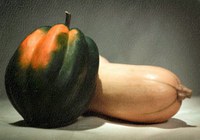Prairie Fare: Squash Soup Warms an Autumn Evening
(Click the image below to view a high-resolution image that can be downloaded)
By Julie Garden-Robinson, Food and Nutrition Specialist
NDSU Extension Service
“Did you dump your soup down the sink?” my husband asked our 10-year-old daughter as he picked up the empty bowl by our kitchen sink. I saw him examining the sink for soup residue.
“No, I ate it,” she answered innocently.
“Do you know what was in the soup?” he asked. He sounded surprised.
She responded to the interrogation with furrowed eyebrows and her hands on her hips. “What did I eat, anyway?” she asked.
“You ate squash soup,” he replied.
I was eavesdropping, but I couldn’t help but jump in the conversation at this point.
“What did you think of the soup?” I asked.
“I liked it,” she replied with a grin. She didn’t even have a “deer in headlights” look on her face when she heard the word squash.
Our picky eater has left the building, at least for that meal. Now that I know she likes squash, I might offer some spaghetti squash with pasta sauce.
We weren’t trying to be sneaky by adding pureed winter squash to soup. We had visited a pumpkin and squash patch recently, and she had helped pick out our “trophies.” Usually, we simply bake squash, then mash it and add a little butter and brown sugar on top. We decided to try a savory recipe instead of a sweet one.
When you mix nutrient-rich, orange-fleshed squash with chicken broth, sautéed onions and spices, you have a hardy, delicious autumn soup that fills your home with a delicious aroma.
Beta carotene is the natural pigment in squash responsible for the dark orange color of its flesh. Our bodies use beta carotene to make vitamin A, which helps us maintain our night vision and healthy skin. Squash also provides fiber, potassium and vitamin C.
Squash has been used as a nutritious food for thousands of years in North America, and we have several types to choose from. You might find buttercup, butternut, acorn and/or spaghetti squash in your local grocery store.
Choose squash that is heavy in relation to its size. Look for squash without bruises, cuts or soft spots. Squash will maintain its quality for many months if stored in a cool, dry place. However, spaghetti squash has a shorter shelf life of about two months.
Do not rinse squash before storing, though, because that will hasten spoilage. Just before use, rinse squash thoroughly and use a produce brush to clean the hard outer rind.
Squash is very easy to prepare. It can be baked whole or cut in half. It can be cooked in a microwave oven or cut in chunks and boiled on a stovetop. You can freeze cooked, mashed squash in recipe-sized amounts in freezer bags or freezer containers. However, home canning mashed squash (or pumpkin) is not recommended because of safety issues.
To bake a whole squash, simply pierce the skin in several places with a knife and place it in a pan. The piercing process releases steam during cooking and prevents a disaster in your oven. At 350 F, a medium-sized whole squash will take about an hour to cook. After baking, peel, remove the seeds and mash or puree the squash, if desired.
Try making an easy oven dinner by preparing a meat loaf, baked potatoes, squash and apple crisp at the same time. Squash can be baked at a variety of oven temperatures.
This squash soup recipe is courtesy of University of Tennessee Extension. Make it a meal with a side salad, French bread or rolls, milk and apple crisp for dessert.
Creamy Squash Soup
1/4 c. butter
1 medium finely chopped onion
6 c. peeled and cubed butternut squash
3 c. chicken broth (plus extra to adjust consistency if needed)
1/8 tsp. cayenne pepper
1/4 tsp. black pepper
3/4 tsp. dried rubbed sage (or to taste)
16 ounces light cream cheese
In a large saucepan, sauté onions in butter until tender. Add squash, chicken broth, cayenne and black pepper, and sage. Bring to a boil and cook 20 minutes or until squash is tender. Puree the squash mixture and cream cheese in a blender or food processor in batches until smooth. Return to saucepan and heat through. Do not allow to boil. If it needs thinning, add additional chicken broth until desired consistency is reached.
The recipe was analyzed with reduced-sodium chicken broth.
Makes eight servings. Each serving has 250 calories, 14 grams (g) of fat, 9 g of protein, 21 g of carbohydrate, 5 g of fiber and 360 milligrams of sodium.
(Julie Garden-Robinson, Ph.D., R.D., L.R.D., is a North Dakota State University Extension Service food and nutrition specialist and professor in the Department of Health, Nutrition and Exercise Sciences.)
NDSU Agriculture Communication – Oct. 31, 2013
| Source: | Julie Garden-Robinson, (701) 231-7187, julie.garden-robinson@ndsu.edu |
|---|---|
| Editor: | Rich Mattern, (701) 231-6136, richard.mattern@ndsu.edu |


